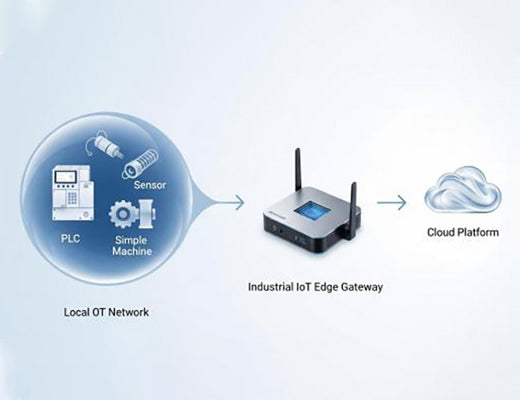
How to Use an IoT Edge Device as a Gateway: A Practical Guide
|
|
Time to read 6 min
|
|
Time to read 6 min
In many industrial IoT deployments, not every sensor or machine can (or should) connect directly to the internet. This creates a critical challenge: how do you securely connect these "downstream" devices to your cloud platform?
This guide provides a practical answer by explaining how to use a powerful IoT Edge device as a gateway. We'll move beyond theory and explore the different gateway patterns—including transparent and protocol translation—and what they mean for your architecture.
Using the Robustel EG5120 as a real-world example, you'll learn how to bridge the gap between your local devices and the cloud, creating a secure, efficient, and scalable IoT solution.

I've seen it countless times: an engineer has a factory floor full of valuable legacy equipment speaking Modbus, or a collection of simple Bluetooth sensors, but no easy way to get their data to the cloud. These devices weren't designed to speak modern internet protocols. They are effectively on data islands. So, how do you solve this "last mile" connectivity problem?
The answer is to use a more intelligent device as an intermediary. Instead of a simple modem, you can use a powerful IoT Edge device as a gateway . This approach means deploying a local computer, like an Industrial IoT Edge Gateway , that acts as a secure front door to the internet for all your other devices. This guide will break down the different ways you can configure an IoT Edge device as a gateway and show you how to implement one of the most common and powerful patterns.
Think of this as the simplest approach.
What it is: In a transparent gateway pattern, the edge device simply passes traffic between the downstream devices and the cloud platform (like an IoT Hub). The downstream devices have their own identities in the cloud and communicate through the gateway.
How it works: The gateway handles the secure connection to the cloud, but it doesn't manipulate or understand the content of the messages. It's like a transparent, secure pipe.
When to use it: This pattern is great when your downstream devices are already capable of speaking modern protocols (like MQTT or HTTPS) but cannot connect to the internet directly due to network policies or firewalls.
This is where the real power of using an IoT Edge device as a gateway comes into play for most industrial applications.
What it is: In this pattern, the edge gateway acts as a smart translator. It communicates with downstream devices in their native language (e.g., Modbus, OPC UA, or even a custom serial protocol) and then converts that data into a modern, standardized format (like MQTT) for the cloud.
How it works: The downstream devices don't need to know anything about the internet or the cloud. They only talk to the local gateway. The gateway is responsible for all protocol conversion, data formatting, and cloud communication.
When to use it: This is the essential pattern for connecting legacy industrial equipment (OT) to modern IT systems . It's the solution for bringing your PLCs, VFDs, and serial-based sensors into your Industry 4.0 system.
Powerful NXP i.MX 8 Processor: Its quad-core CPU has the horsepower to handle multiple protocol translations and run custom logic simultaneously.
Rich Industrial Interfaces: It has built-in RS232/RS485 serial ports and DI/DO, allowing it to connect directly to industrial equipment without needing extra adapters.
Debian-based OS & Docker: RobustOS Pro provides a familiar Linux environment and Docker support , making it incredibly easy to deploy software for protocol translation, such as a Node-RED flow or a custom Python script in a container.
Connect: A Modbus RTU temperature sensor is connected to the EG5120's RS485 port.
Translate & Process: A Node-RED flow running on the EG5120 polls the sensor's Modbus register every 10 seconds. It takes the raw integer value, converts it into a floating-point number representing Celsius, and formats it into a JSON payload like {"temperature": 25.5}.
Publish: The gateway then uses its integrated 4G cellular connection to publish this clean JSON data to an MQTT topic in the cloud.
In this case, the legacy Modbus sensor is now a fully-fledged cloud-connected IoT device, all thanks to the IoT Edge device acting as a gateway.

When a single device acts as a gateway for many others, its security is paramount.
Securing the Gateway Itself: The gateway's OS must be hardened. Look for features like a secure boot process , a strong firewall, and a development lifecycle certified to standards like IEC 62443-4-1 .
Securing Downstream Connections: The network between your downstream devices and the gateway should be physically secured and isolated.
Securing the Cloud Connection: The connection from the gateway to the cloud must be encrypted using secure protocols and strong VPNs like Wireguard or OpenVPN .
A1: A simple router just forwards IP traffic. An IoT Edge device as a gateway is an intelligent computer. It can understand and translate non-IP protocols (like Modbus), run custom applications locally (edge computing), and manage the identities and security for downstream devices.
A2: Not all. The ability to function effectively as a protocol translation gateway depends on the device having the right physical interfaces (like serial ports), a flexible OS (like Debian-based RobustOS Pro), and support for running custom software (like Docker containers).
A3: This depends on the gateway's processing power and the amount of traffic each device generates. For simple protocol translation with low data rates, a powerful device like the EG5120 could handle dozens or even hundreds of downstream devices.